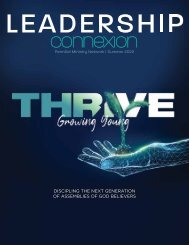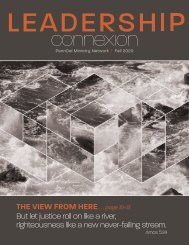Leadership Connexion FALL 2023
Create successful ePaper yourself
Turn your PDF publications into a flip-book with our unique Google optimized e-Paper software.
TE OR STAGNATE<br />
INCIPLE<br />
ears on doctoral work, working with established<br />
approaches and coaching many leaders, I have<br />
s and organizations of all sizes and styles:<br />
TINUOUS RECALIBRATION,<br />
EADILY DRIFT OFF MISSION. PERIOD!<br />
Recalibrating is something more than a practice, an event, or a moment. It is<br />
a perspective and a way of viewing your entire ministry and organization. It<br />
becomes a cultural norm, a way to approach every aspect of leadership and<br />
church life.<br />
The theory of the bell curve states that every organization will hit its peak,<br />
at which time it must either reinvent itself or go backward. Every successful<br />
leader knows this intuitively. So you often see signs that say, “Grand Opening,”<br />
or “Under New Management.” It’s why Apple always seems to be releasing<br />
new versions of its iPhone or iPad. When you infuse a culture of recalibration<br />
into your church, you make sure that your church will never hit the peak of<br />
the bell curve and then begin to drift inexorably downward. This one practice<br />
allows you to get ahead of the bell curve.<br />
How Often Do I Need to<br />
Recalibrate? Church leaders tend to want to find the latest silver bullet or hit<br />
program they need to grow their churches. We all want to add the latest piece<br />
of software . . . but few of us want to update the church’s cultural operating<br />
systems. This comes to the forefront in one of the first questions leaders often<br />
ask me: “How often do I need to recalibrate?” While nothing is wrong with this<br />
question, let me assure you, it’s not that easy!<br />
The real challenge is to create a culture of recalibration. You must create<br />
a culture of recalibration that becomes an integral part of the life and<br />
bloodstream of your church, a culture where change becomes normal and<br />
not a process that puts the church into a tailspin. To recalibrate effectively, you<br />
have to infuse new principles into your congregation and build new leadership<br />
muscles in your own life.<br />
When leaders ask how often they need to recalibrate, it<br />
reveals that they tend to create events and programs,<br />
rather than creating a culture that transforms every<br />
spectrum and facet of the organization. The real goal,<br />
therefore, is to create a culture of recalibration, not<br />
merely a series of cosmetic changes. The goal is to<br />
create a new cultural norm, not a pile of hype that<br />
will get you some quick results but more than likely<br />
frustrate a lot of people.<br />
THE EARLY<br />
CHURCH<br />
RECALIBRATED<br />
ACTS 2. The Holy Spirit recalibrated the<br />
people of God and empowered them<br />
to take the gospel to Jerusalem, Judea,<br />
Samaria and the uttermost parts of the<br />
earth.<br />
ACTS 6. God recalibrated the early<br />
church leadership. As the church<br />
grew, no longer could the ministry be<br />
contained to the twelve apostles. So they<br />
recalibrated and empowered others in the<br />
church to do ministry - and so the church<br />
grew again.<br />
ACTS 10. Peter himself faced a<br />
recalibration of huge significance. This<br />
is perhaps the most radical recalibration<br />
in Scripture: God speaks to Peter and<br />
shows him that the ethnic and cultural<br />
barriers to faith have been cast down.<br />
Gentiles now have unhindered access to<br />
the grace of God.<br />
ACTS 11 AND 13. The church<br />
recalibrated because of the martyrdom of<br />
Stephen and the persecution of the early<br />
church. The church scattered throughout<br />
the region, a few of them taking the<br />
gospel to the Gentiles in Antioch. At<br />
Antioch, the name of the movement<br />
got recalibrated to “Christians.” New<br />
leadership emerged, especially through<br />
Barnabas and Saul. The church at<br />
Antioch sent out the church’s first<br />
missionaries to the entire Roman Empire.<br />
ACTS 15. The church experienced a<br />
theological recalibration. At the Jerusalem<br />
Council, Peter and James recalibrated<br />
what was required for salvation in<br />
relationship with Jewish customs and the<br />
role of grace in the life of all believers.<br />
LEADERSHIPconnexion | Fall <strong>2023</strong> 7

















